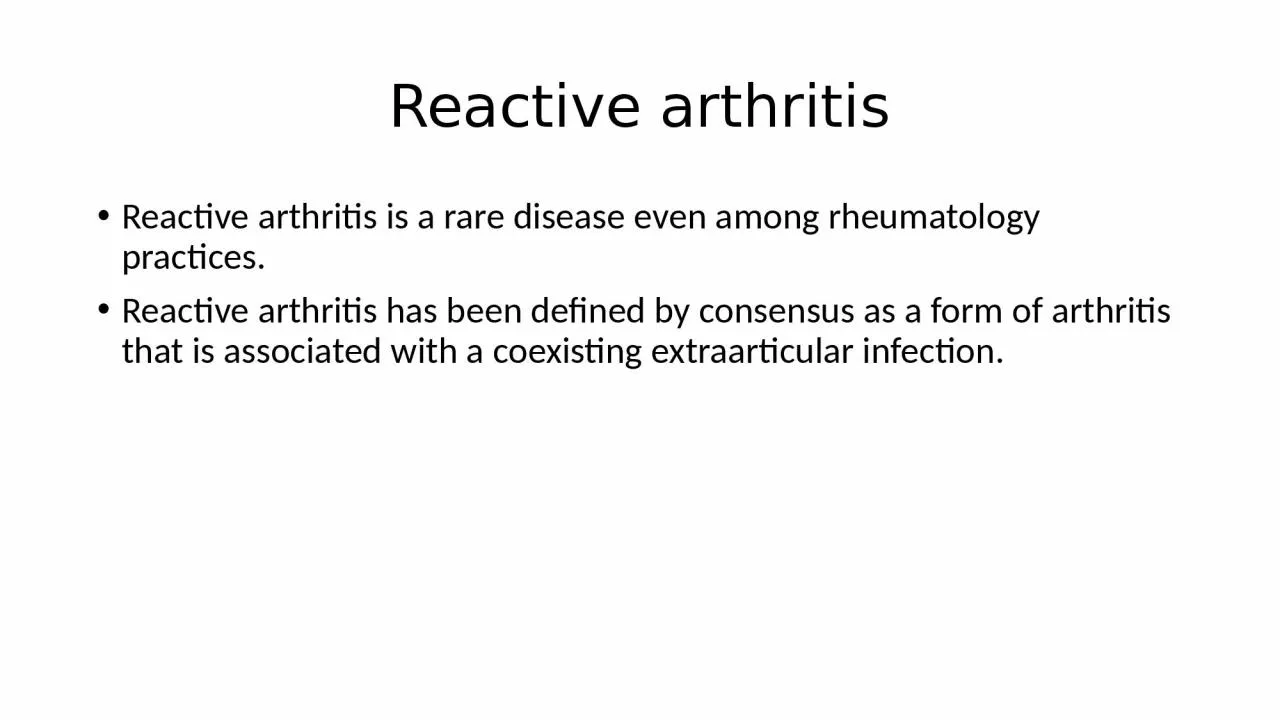

Reactive arthritis has been defined by consensus as a form of arthritis that is associated with a coexisting extraarticular infection Reactive arthritis Only certain enteric and genitourinary pathogens are conventionally accepted as capable of causing reactive arthritis ID: 1037771
Download Presentation The PPT/PDF document "Reactive arthritis Reactive arthritis is..." is the property of its rightful owner. Permission is granted to download and print the materials on this web site for personal, non-commercial use only, and to display it on your personal computer provided you do not modify the materials and that you retain all copyright notices contained in the materials. By downloading content from our website, you accept the terms of this agreement.
1. Reactive arthritisReactive arthritis is a rare disease even among rheumatology practices.Reactive arthritis has been defined by consensus as a form of arthritis that is associated with a coexisting extraarticular infection.
2. Reactive arthritisOnly certain enteric and genitourinary pathogens are conventionally accepted as capable of causing reactive arthritis. Chlamydia trachomatis, Yersinia, Salmonella, Shigella, Campylobacter, Clostridioides (formerly Clostridium) difficile, and Chlamydia pneumoniae.
3. Reactive arthritisMusculoskeletal features of reactive arthritis typically develop one to four weeks following an acute infection with one of the triggering organisms. At least one of the following is seen in all patients with this condition: asymmetric oligoarthritis (often affecting the lower extremities)enthesitis dactylitisinflammatory back pain.
4. Extraarticular manifestations occur in some patients, but none are specific for reactive arthritis. These include eye involvement, most often with conjunctivitis, but infrequently with anterior uveitisgenitourinary tract symptomsoral mucosal ulcerscutaneous manifestations such as keratoderma blennorrhagica, circinate balanitis, and psoriasis-like nail changes.
5. Laboratory findings may include evidence of the infection, elevated acute phase reactants, and findings of inflammatory joint fluid in patients with arthritis.
6. Antibiotic therapy should be used for treatment of active Chlamydia trachomatis infection, if present. In general, antibiotics are not indicated for uncomplicated enteric infections or for treatment of the arthritis itself.We suggest treatment of arthritis in most patients initially with nonsteroidal antiinflammatory drugs (NSAIDs) In patients who do not respond adequately to NSAIDs, we suggest intraarticular glucocorticoids, rather than initiating therapy with daily oral glucocorticoids or a DMARD.
7. In patients who do not respond adequately to NSAIDs and intraarticular glucocorticoid injections, we suggest low to moderate doses of systemic glucocorticoids, rather than initiating treatment with a DMARD. A typical dose would be prednisone, 20 mg daily, titrated to the lowest dose required to control symptoms
8. In patients who have not responded adequately to NSAIDs over at least four weeks and who require ongoing therapy with more than 7.5 mg of prednisone or equivalent for more than three to six months we suggest a trial of a nonbiologic DMARD, rather than continuing moderate to high dose glucocorticoids without a DMARD. We usually prescribe sulfasalazine. Methotrexate is an alternative to SSZ.
9. The prognosis is good in the majority of patients, with spontaneous remission within 6 to 12 months of onset of arthritis. However, some patients have persistent but mild musculoskeletal symptoms, and others develop radiologic evidence of joint injury and evolve to a more chronic form of SpA.